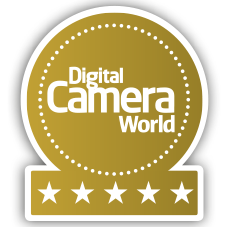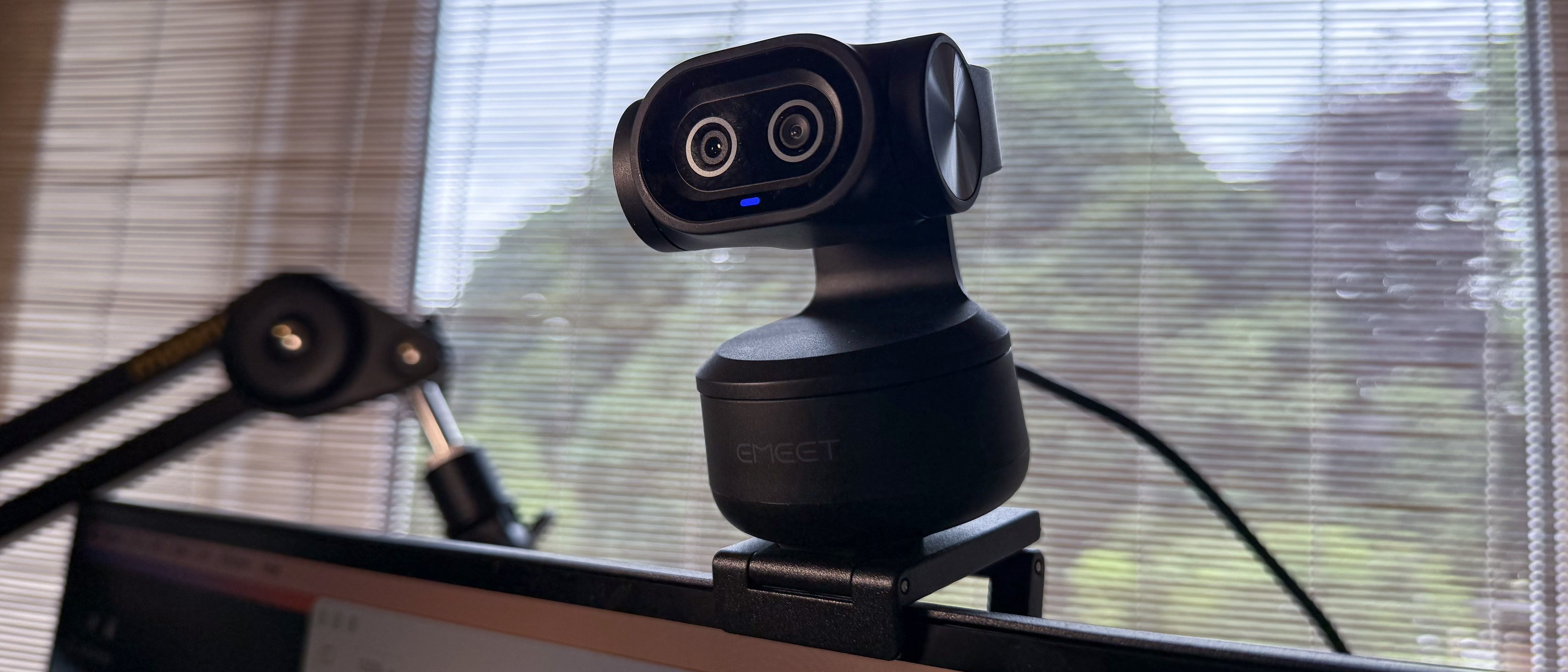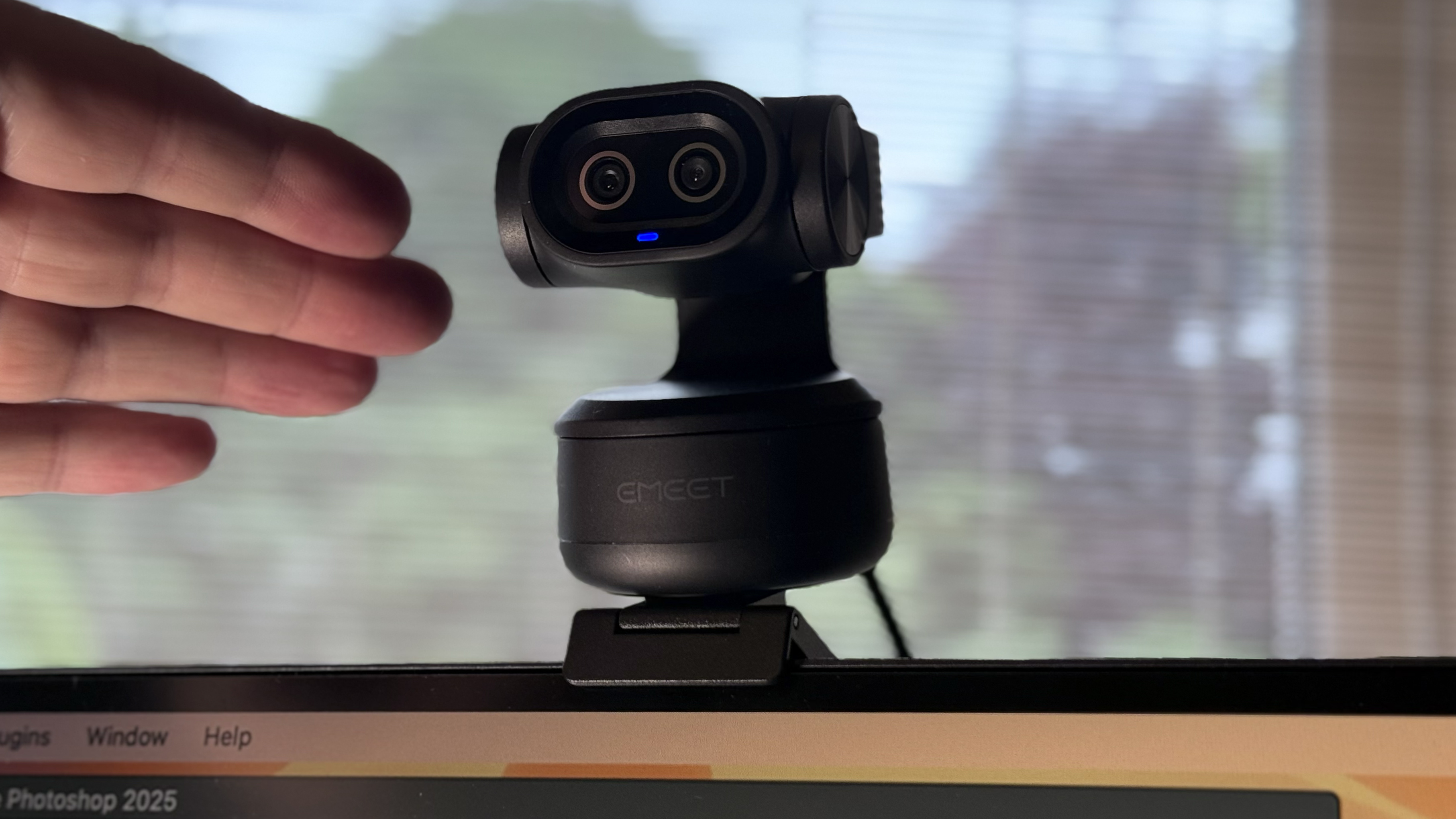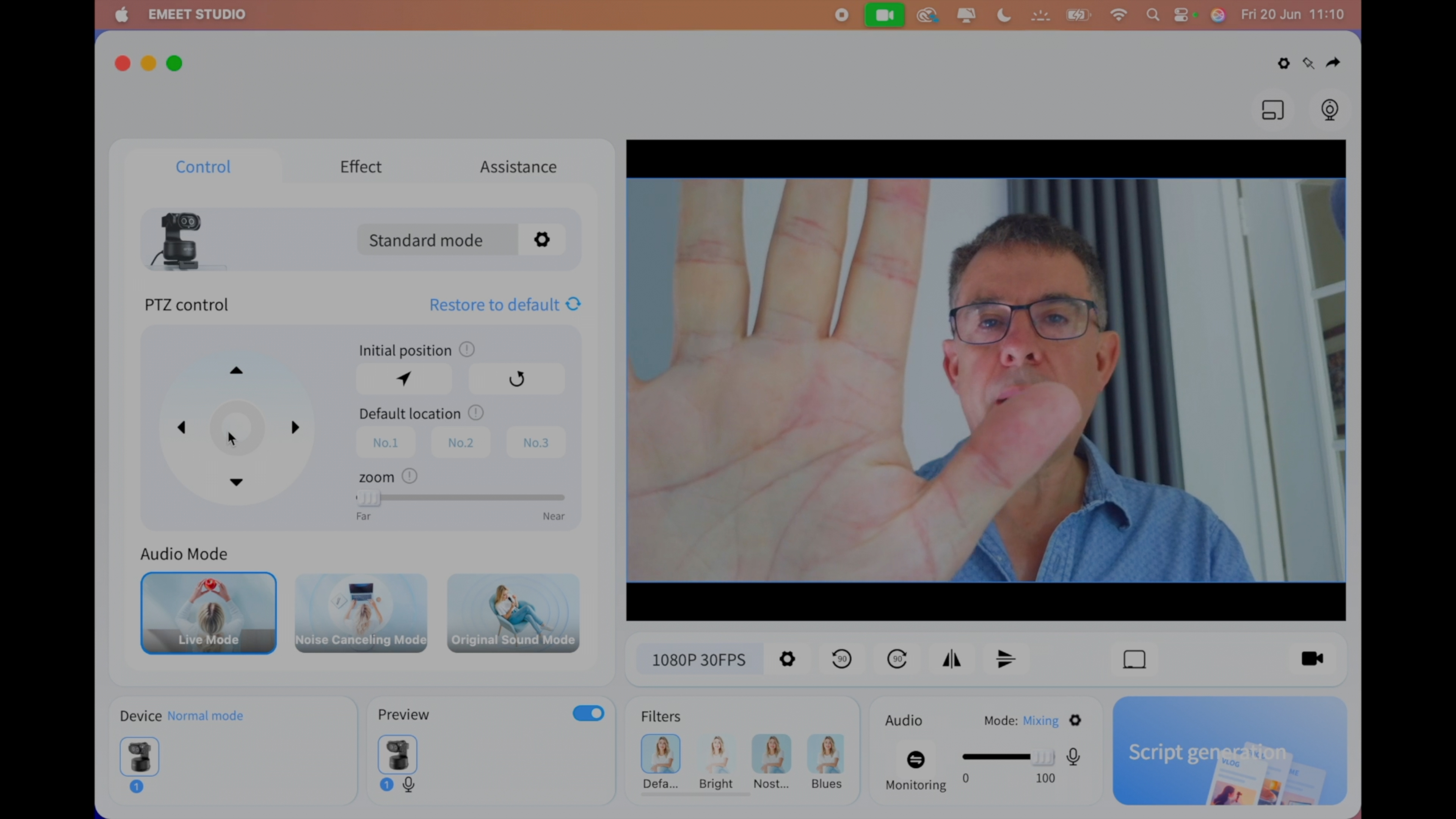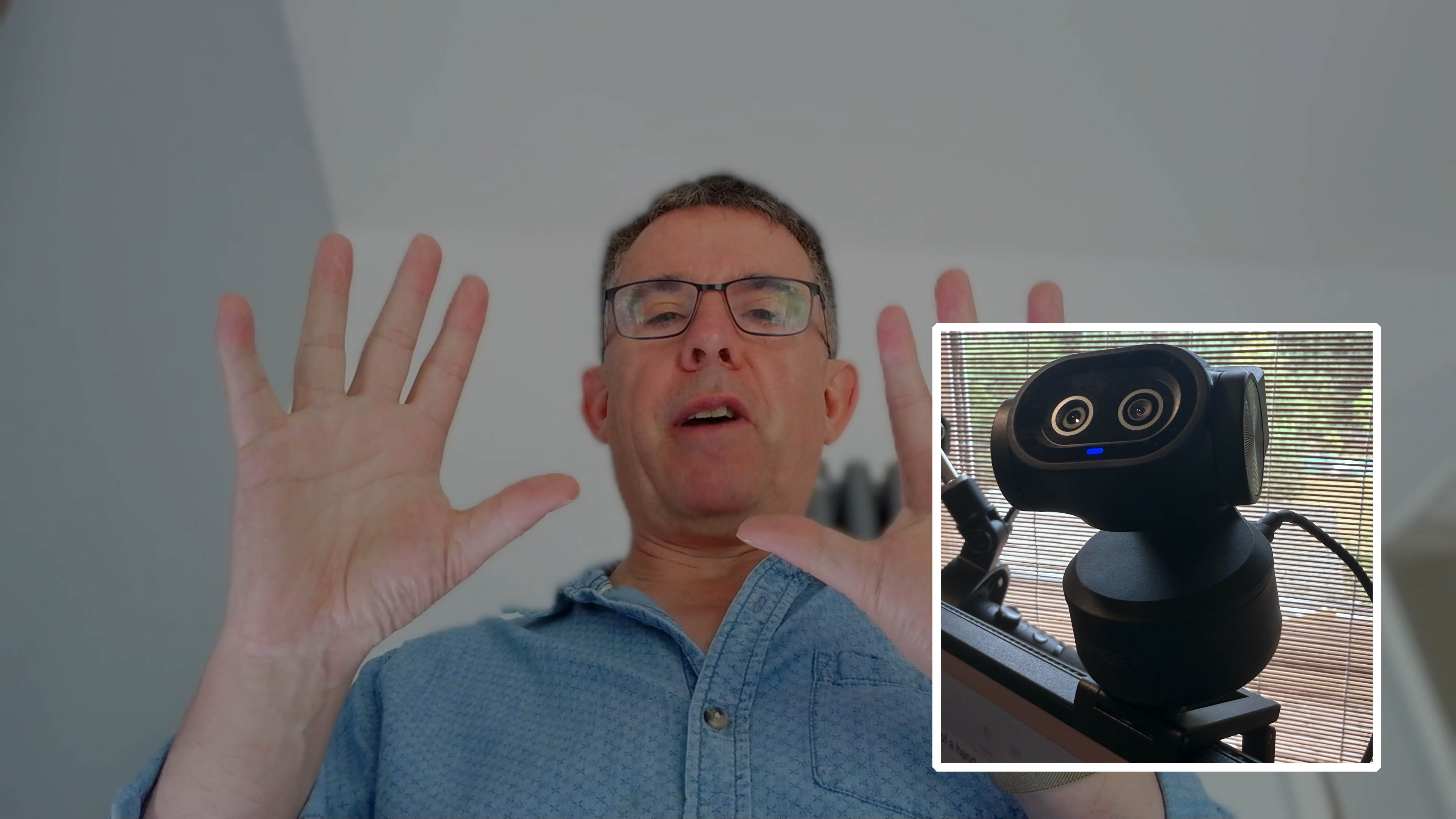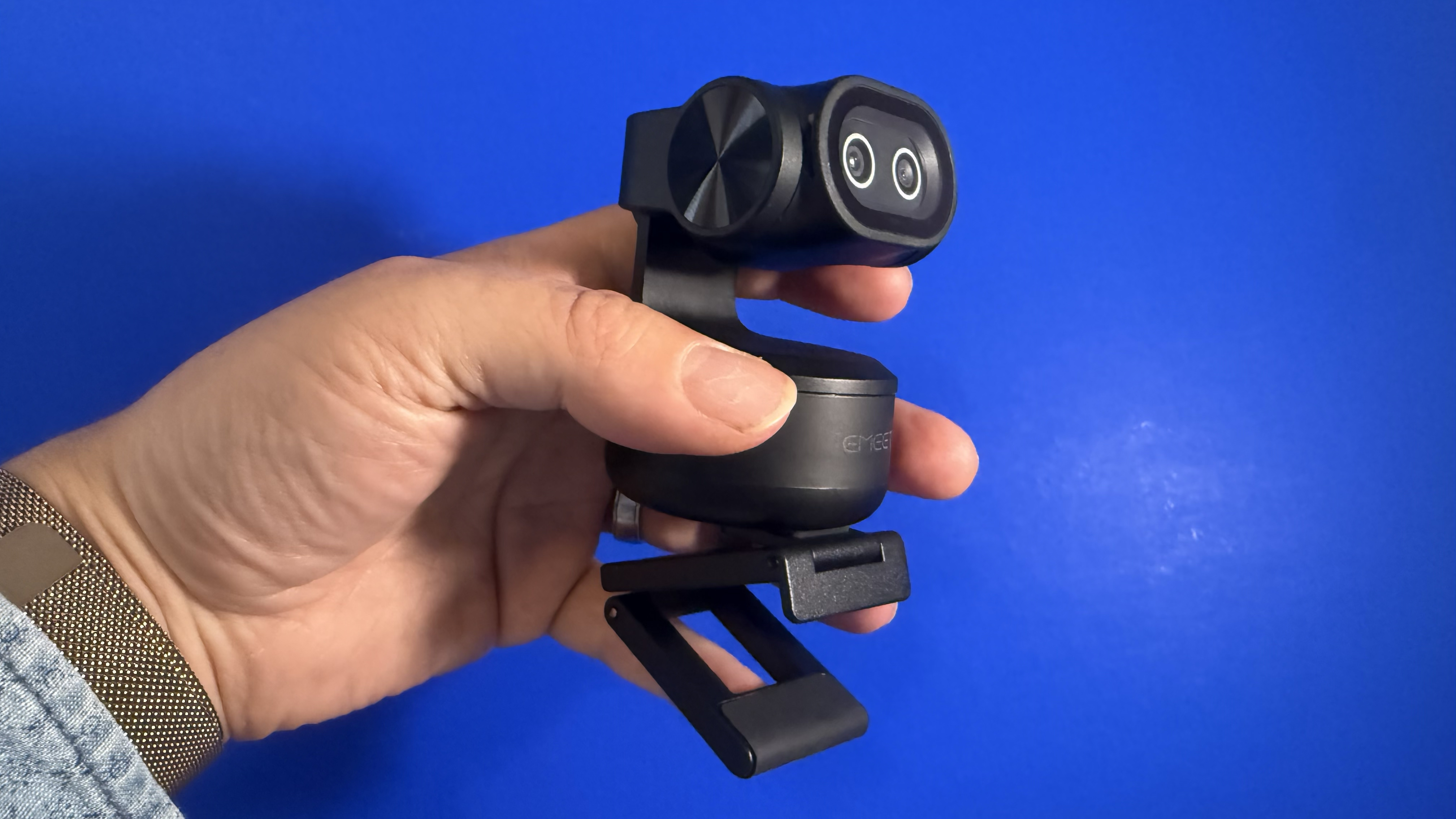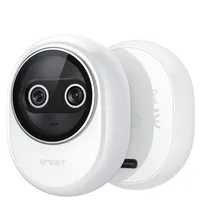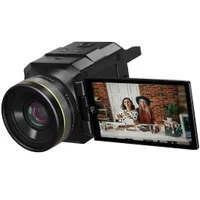Digital Camera World Verdict
The Emeet Pixy Dual-Camera PTZ 4K Webcam is essentially a mini gimbal that perches on top of your computer's display. Despite looking like a baby robot bird, it captures / streams excellent-quality footage in a range of mixed lighting conditions and will even reduce background sounds via its built-in mics. You’ll never tire of holding up your palm to trigger the AI-tracking, which pans and tilts the Pixy’s dual-camera smoothly to follow your movements like a skilled camera operator. Some laptop webcams offer digital PTZ to keep you in the frame, but they won’t be able to keep up with the Pixy’s ability to pan through 310º or tilt through 180º. It's fantastically functional and cute to look at!
Pros
- +
Pans and tilts through a wider range than a built-in webcam
- +
AI-powered tracking
- +
Excellent picture quality in mixed lighting scenarios
Cons
- -
Only zooms manually
- -
Pricier than ‘static’ webcams
Why you can trust Digital Camera World
Hong Kong-based company Emeet was founded in 2016 and was initially known for producing business-focused cameras, such as the Emeet Owl 4+, a 360º panoramic camera that captures everyone around the table in a board meeting.
The company has since expanded its range to produce smart cams designed to meet the everyday needs of home computer users, like the Emeet SmartCam S800 – which sits on top of your PC so that you can stream live footage via OBS Studio, chat to friends and family in a Zoom call, or record a high-quality ‘talking head’ intro for your YouTube channel via apps such as QuickTime.
I wasn't a big fan of the S800 due to its struggle to get a balanced exposure in high-contrast lighting scenarios, but I was much more impressed with the newer, cheaper and more effective Emeet Piko+, due to a combination of excellent picture quality, affordability and a distinctive dual-lens design that – combined with its oval body – is reminiscent of a tiny robot owl. Very cute!
The Emeet Pixy is an evolved version of the Piko+. While the Piko+ sits immobile on its supplied mini tripod and stares in whichever direction you point it, the Pixy is built into a mini gimbal. This enables the Pixy to pan and tilt to follow your every move, so you can stand up and walk about (instead of being glued in front of your laptop or PC while talking to an immobile webcam).
The gimbal component explains the PTZ initials in Pixy’s full name – pan, tilt, zoom – and thanks to this gimbal, Pixy is a game-changer when it comes to webcams, as I’ll explain.
Emeet Pixy Dual-Camera PTZ 4K Webcam: Specifications
Camera | Dual Camera 4K, AI assisted, Sony 1/2.55in sensor |
Built-in Mics | 3 |
Sound Modes | Live, Original, Noise Reduction |
Pan angle | 310º |
Tilt angle | 180º |
Video Resolution | 4K @ 30fps / 1080p @ 60fps |
FOV(D) | 73º |
Max gesture tracking distance | 6 meters (19.7 feet) |
Dimensions | 56mm x 43mm x 22mm |
Weight | 120g (198g when mounted on stand) |
Emeet Pixy Dual-Camera PTZ 4K Webcam: Price
The Emeet Pixy officially retails at $159.99 / £149.99 / AU$279.99. Its predecessor – the Piko+ – retails at $70 / £60 / AU$134. If you're happy staring at a statically mounted webcam and have it stare back at you, then the older and cheaper Piko+ will do a great job.
However, if you want the freedom to stretch your legs while in a Zoom meeting or you want to walk and talk while recording a QuickTime movie, then the gimbal-mounted Pixy is well worth the extra cost, as it will keep you in the picture at all times.
The best camera deals, reviews, product advice, and unmissable photography news, direct to your inbox!
Personally, the Emeet Pixy suits my needs, and the price is attractive. I’ll tell you why. I have a 2023 15in MacBook Air, which has a built-in FaceTime HD camera. However, unlike newer models, my MacBook Air’s FaceTime Camera doesn’t support Centre Stage.
Centre Stage uses software to make the feed from the FaceTime HD camera pan, tilt, and zoom to keep you in the frame (as if the camera was mounted on a tripod). To enjoy Centre Stage in my video calls, I’d need to spend $1,200 / £1,200 / AU$2,100 on a newer MacBook Air, which is not something I can afford.
The Emeet Pixy is a fraction of the cost of a new MacBook, but it enables me to present to a camera that will pan and tilt in a similar way to Centre Stage. Plus, Centre Stage can’t tilt to keep my face in shot if I stand up, and its panning angle is far narrower than the Pixy’s 310º.
So, in short, I think the Pixy’s price is right (especially as the Ultra HD image quality of the Pixy’s feed looks better than footage streamed from my MacBook Air’s FaceTime HD camera).
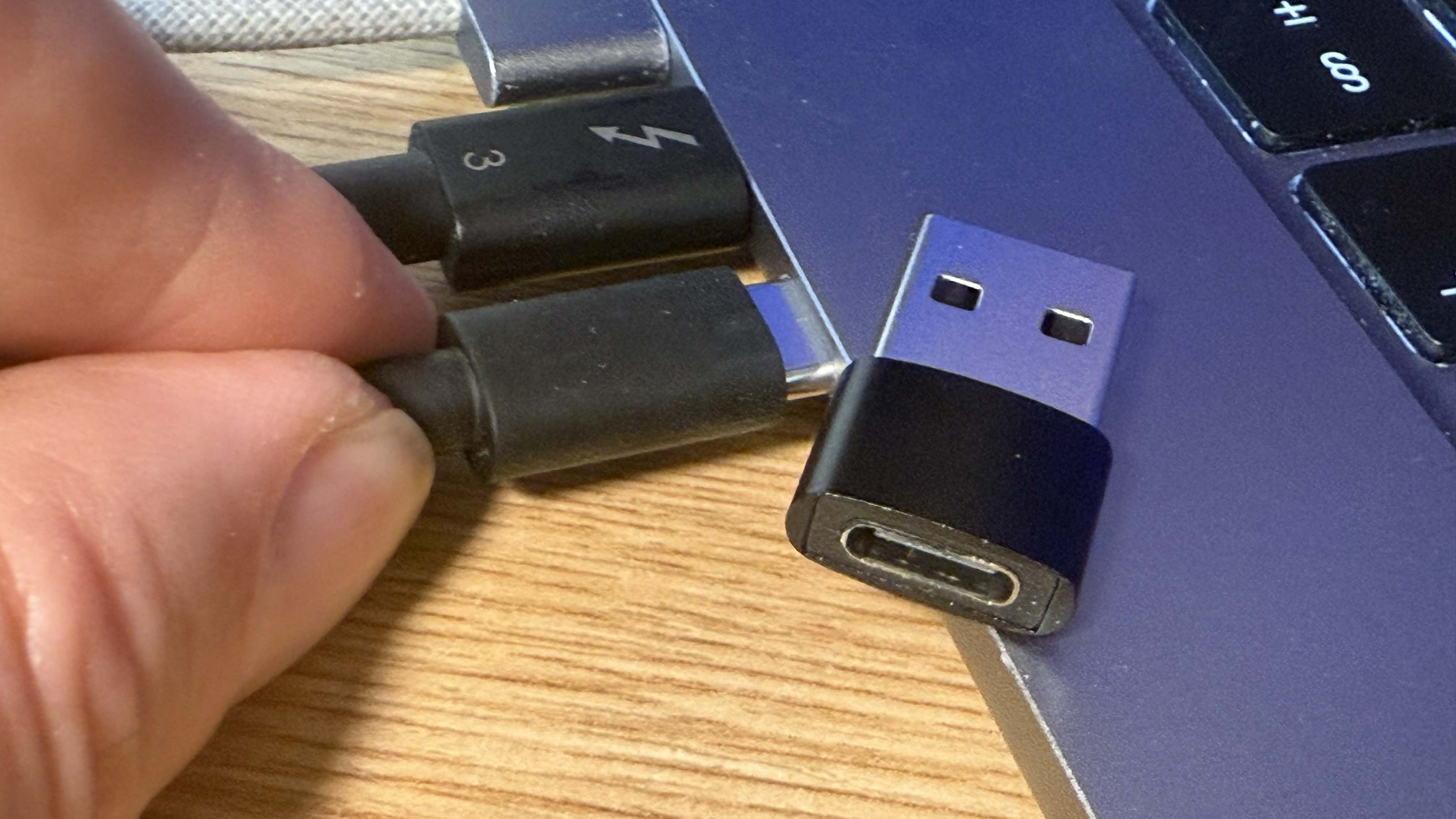
Emeet Pixy Dual-Camera PTZ 4K Webcam: Design & Handling
On unboxing the Emeet Pixy, I was instantly impressed by its weight. Despite being made of plastic, it felt sturdy and well-built, especially when compared to the older and cheaper Emeet Piko+, which is basically a small oval bit of plastic that weighs in at a lightweight 39g compared to the heftier 120g Pixy.
I was intrigued to see that the Pixy is built into a mini gimbal. I’ve enjoyed using gimbals such as the Hohem iSteady M7 to make my iPhone 16 Pro’s camera follow me on location, courtesy of an AI sensor.
It’s very liberating to be able to walk and talk while presenting to the camera with an AI-powered camera operator smoothly tilting and panning to follow my every move. The Pixy’s combination of gimbal construction and AI chip means that I can enjoy a similar level of freedom of movement when using a webcam at home.
The Pixy’s side-by-side dual-cameras look like a pair of eyes, and the urge to anthropomorphize the camera is further encouraged by a little horizontal status LED below the eyes that gives the ‘face’ a ‘mouth’. I was intrigued to see that the dual-camera ‘face’ of the Pixy was clamped between two cylindrical ‘ears’ which rotate to tilt the face up and down.
The face and tilt motors are situated at the top of the Pixy, with a 'neck' connecting them to a pan motor that sits on top of a little cylindrical 'body'. Thanks to the combination of face, neck, and body, I found that the Pixy reminded me of a baby bird, especially when, after unboxing it from its cardboard box ‘nest’, it stared up at me while sitting on my desktop.
The ‘eyes’ of the Pixy aren’t just there to make it look cute. The left camera (as you look at the ‘face’) sends a 4K UHD feed to the Pixy’s 1/2.55in Sony Sensor. The right camera is the Portrait Camera, which uses AI to ensure that the face is in focus at all times.
AI also helps ensure natural-looking skin tones and a perfect highlight/shadow balance when it comes to exposure. Using BlinkFocus technology, the Pixy is able to adjust focus in a speedy 0.2s, so you’ll always stay sharp when in shot. This focus adjustment is, according to Emeet, 2.5x faster than the industry average.
The Pixy ships with a little metal mount. It’s an easy job to screw the mount’s thread into the base of the Pixy’s body and then hook the mount on top of your PC or laptop’s screen. You can then adjust the mount’s hinge so that the camera is pointing at a suitable angle to display you in shot.
Once mounted, the Emeet Pixy sits on top of your PC’s display like a baby bird perched on a branch. I did say that it is cute!
Emeet Pixy Dual-Camera PTZ 4K Webcam: Performance
When it comes to setting it up, the Emeet Pixy is pretty much ‘plug and play’. It ships with a USB-C to USB-C cable (and comes with an adapter to connect it to older computers via a standard USB Type-A socket). Once plugged into your PC, you can access the camera from a range of apps, such as Zoom or QuickTime.
You should also download the free Emeet Studio software, as this enables you to take more control over the Pixy, such as adjusting the footage’s resolution and frame rate. Emeet Studio also has a Privacy switch, which causes the camera to tilt up at the ceiling and go blank so that you’re no longer in shot.
Oh, you can also use the Studio software to update the Pixy’s firmware, which I did just before testing it. I’ll talk more about Emeet Studio later in this section, and you can see the software (and camera) in action in my supporting video.
I tested the Pixy with it mounted on my MacBook Air’s display. I made the mistake of closing the hinged display while the Pixy was still attached, and it flopped forward, nose-diving onto my desk with a clatter.
The little mouth-shaped LED turned orange to indicate that the Pixy was a bit dazed and confused by its fall, but it quickly tuned back to blue once I re-mounted it on my Mac. A blue ‘mouth’ indicates that the Pixy is in tracking mode, so the gimbal’s neck will rotate, and its head will tilt to follow your face at all times.
I found that the AI-powered tracking was relatively effective. When I leaned left or right, the camera panned smoothly to keep me in shot. I’m a freelance camera operator, so I’m fairly quick at panning to keep a subject in the centre of the frame. The Pixy’s AI-powered panning gimbal was slightly slower than a human operator to respond to movement, but only by a delay of just under a second.
The camera eases in and out of pans naturally and smoothly, just like a human operator. The Pixy was slightly slower to respond when I suddenly stood up. It did tilt to get me back in shot, but this move took around three seconds.
To test the range of the pan and tilt, I stood up and wandered around the room. When the Pixy is happily tracking you, its ‘mouth’ lights up blue. If it loses you, the ‘mouth’ turns orange. When I walked behind my Maono PD300X mic on its metal boom arm, the Pixy lost sight of my face, causing blue to turn orange. However, it was quick to recognize me when I reappeared, and it continued to track my face as I returned to my seat.
The Emeet Pixy is hailed by its publicity as the "world’s first Dual-Camera AI PTZ 4K Webcam". PTZ stands for 'pan, tilt, zoom', as I mentioned earlier. The Pixy does indeed use AI to pan and tilt the gimbal that’s holding the camera. However, I also expected it to perform an AI-assisted digital zoom to keep my face larger in the frame when I leaned back in my chair (like you get when using Apple’s Centre Stage feature).
When streaming 1080p resolution footage, you can get the Pixy to zoom in digitally by manually dragging a slider in the Emeet Studio app, but all that’s doing is cropping into a 4K resolution image. If you choose to stream in full 4K, then you can’t use the digital zoom feature.
Emeet Studio has a range of controls to fine-tune the behaviour of the Pixy. In Standard Mode, there’s an onscreen joystick that is designed to let you manually pan and tilt the Pixy, but this is really cumbersome to use and you tend to watch the Pixy swinging wildly back and forth before eventually getting your face in the frame.
It is much easier to hold up your palm to the Pixy and trigger its Tracking Mode. The green mouth on the Pixy turns to blue to indicate that the Pixy will now track your face. Hold up your palm again to revert to the static Standard Mode, where the Pixy behaves more like a classic webcam.
In Standard Mode, you can use the virtual joystick to set up three different camera positions. You can then get the camera to pan to each position in a click. This could be handy if you want the camera to pan from your face to a product on you desktop, for example, during a Zoom chat.
As well as capturing/streaming great-quality video, the Pixy boasts three microphones built into its body. The Emeet Studio app enables you to switch between three audio presets. Live Mode applies automatic gain control and eliminates ambient device noise, such as air purifiers or fans. This could be useful when using the Pixy at home.
Noise Cancelling Mode analyses the signals from the multiple microphones and isolates the desired sound source while filtering out background noise and reverberation, so this could be handy when working in a noisier location, such as a coffee shop. Noise cancellation can affect the audio quality of your voice, so you can stick to Original Sound Mode if working in a quiet environment.
I found that the audio quality from the Emeet Pixy’s built-in mics was a bit thin and over-sharp (especially in Noise Cancelling Mode) compared to fuller-bodied audio from my Maono mic.
Since I was comparing the Pixy’s footage with the feeds from my MacBook Air’s FaceTime Camera and iPhone 16 Pro Camera, I sourced all my audio from my Maono mic to keep the sound consistent throughout my video review, regardless of which video source I was using.
Emeet Pixy Dual-Camera PTZ 4K Webcam: Verdict
The Emeet Pixy is a game changer when it comes to streaming/recording footage via a PC or laptop. Thanks to the built-in gimbal you are no longer ‘chained’ to your chair during a video chat or online meeting while staring at a webcam.
The Pixy will attentively follow your every move as you stand up to stretch your legs or walk and talk while making a presentation to camera. You’ll also stay in sharp focus when streaming via the Pixy, and your skin tone and facial detail will be clearly visible, even when shooting against a light source.
So if you want a quick and easy way to improve your online presence in meetings, while streaming to YouTube or recording a video presentation then the Emeet Pixy comes highly recommended. I especially like the way you can hold up your palm to trigger AI-tracking and the Pixy’s mouth turns from green to blue, indicating that those cute little dual-camera eyes will be following your every move via smooth tilts and pans.
Features ★★★★★ | Dual lenses enable the Pixy to capture 4K UHD footage and AI-assistance ensures fast and effective face focus. |
Design ★★★★★ | By placing the camera on a gimbal, you have a webcam that will track your every move. |
Performance ★★★★★ | The dual lenses pick out delicate textures and details while streaming a high-contrast, well-exposed feed that stays sharp. |
Value ★★★★★ | It's more expensive than others in the Emeet webcam range, but the freedom to stream while moving about your room justifies this extra cost. |
Alternatives
The Emeet Piko+ has a camera that has a very similar spec as the Emeet Pixy, but it lacks the gimbal mechanics that make the Pixy track your movements. So if you want a traditional static webcam that makes you look better than your PC’s built-in camera without blowing your budget, then the Piko+ is a great choice.
Read the full Emeet Piko+ review
If you need to stream footage 24/7 without the webcam being physically tethered to your PC then the Hollyland VenusLiv Wi-Fi-connected webcam offers a much more expensive alternative to the Emeet Pixy. Its touchscreen gives you more control over properties such as shutter speed and ISO. Strictly for the pros.
Read the full Hollyland VenusLiv review
George has been freelancing as a photo fixing and creative tutorial writer since 2002, working for award winning titles such as Digital Camera, PhotoPlus, N-Photo and Practical Photoshop. He's expert in communicating the ins and outs of Photoshop and Lightroom, as well as producing video production tutorials on Final Cut Pro and iMovie for magazines such as iCreate and Mac Format. He also produces regular and exclusive Photoshop CC tutorials for his YouTube channel.
- Adam WaringGuides Editor
You must confirm your public display name before commenting
Please logout and then login again, you will then be prompted to enter your display name.
